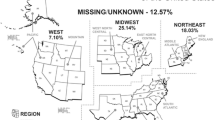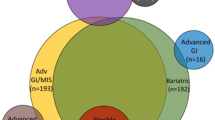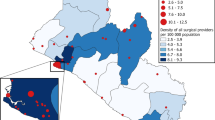Abstract
Introduction
Multiple reports have cited the looming shortage of physicians over the next decades related to increasing demand, an aging of the population, and a stagnant level in the production of new physicians. General surgery shares in this problem, and the specialty is “stressed” by a declining workforce related to increasing specialization that leaves gaps in emergency, trauma, and rural surgical care.
Summary
The Society of Surgery of the Alimentary Tract (SSAT) Public Policy and Advocacy Committee sponsored panel discussions regarding the general surgery workforce shortage at the Digestive Disease Week 2012 and 2013 meetings. The 2012 panel focused on defining the problem. This is the summation of the series with the solutions to the general surgery workforce shortage as offered by the 2013 panel.





Similar content being viewed by others
References
Polk HC, Jr., Bland KI, Ellison EC, Grosfeld J, Trunkey DD, Stain SC, and Townsend CM. A proposal for enhancing the general surgical workforce and access to surgical care. Ann Surg, 2012. 255(4): p. 611–617.
Goldberg R, Reid-Lombardo K, Hoyt D, Pellegrini C, Rattner D, Kent T, Jones D, and SSAT PPACot. Will There Be A Good General Surgeon When You Need One? Journal of Gastrointestinal Surgery, 2013 [Epub ahead of print].
Lynge DC, Larson EH, Thompson MJ, Rosenblatt RA, and Hart LG. A longitudinal analysis of the general surgery workforce in the United States, 1981–2005. Arch Surg, 2008. 143(4): p. 345–350; discussion 351.
Williams TE, Jr. and Ellison EC. Population analysis predicts a future critical shortage of general surgeons. Surgery, 2008. 144(4): p. 548–554; discussion 554–546.
Longo WE, Sumpio B, Duffy A, Seashore J, and Udelsman R. Early specialization in surgery: the new frontier. Yale J Biol Med, 2008. 81(4): p. 187–191.
Lewis FR. Comment of the American Board of Surgery on the recommendations of the Institute of Medicine Report, “Resident Duty Hours: enhancing sleep, supervision, and safety”. Surgery, 2009. 146(3): p. 410–419.
Bucholz EM, Sue GR, Yeo H, Roman SA, Bell RH, Jr., and Sosa JA. Our trainees’ confidence: results from a national survey of 4136 US general surgery residents. Arch Surg, 2011. 146(8): p. 907–914.
Coleman JJ, Esposito TJ, Rozycki GS, and Feliciano DV. Early subspecialization and perceived competence in surgical training: are residents ready? J Am Coll Surg, 2013. 216(4): p. 764–771; discussion 771–763.
Stain SC, Biester TW, Hanks JB, Ashley SW, Valentine RJ, Bass BL, and Buyske J. Early tracking would improve the operative experience of general surgery residents. Ann Surg, 2010. 252(3): p. 445–449; discussion 449–451.
Hudkins JR, Helmer SD, and Smith RS. General surgery resident practice plans: a workforce for the future? Am J Surg, 2009. 198(6): p. 798–803.
Emanuel EJ and Fuchs VR. Shortening medical training by 30 %. Jama, 2012. 307(11): p. 1143–1144.
Dill M and Salsberg E. The Complexities of Physician Supply and Demand: Projections through 2025, 2008, Association of American Medical Colleges: Center for Workforce Studies: Washington D.C. p. 1–94.
Association of American Medical Colleges. Statement on the Physician Workforce, 2006, Association of American Medical Colleges: Washington D.C. p. 1–9.
The American College of Surgeons Health Policy Research Institute. Change in Workforce Across All Surgical Specialties, 2006–2011. United States Atlas of the Surgical Workforce 2012 [cited 2013].
The American College of Surgeons Health Policy Research Institute. Change in Workforce in General Surgery, 2006–2011. United States Atlas of the Surgical Workforce 2012 [cited 2013].
American College of Surgeons Health Policy Research Institute. The Surgical Workforce in the United States: Profile and Recent Trends, 2009.
Goodman DC and Fisher ES. Physician workforce crisis? Wrong diagnosis, wrong prescription. N Engl J Med, 2008. 358(16): p. 1658–1661.
Sirovich BE, Gottlieb DJ, Welch HG, and Fisher ES. Regional variations in health care intensity and physician perceptions of quality of care. Ann Intern Med, 2006. 144(9): p. 641–649.
Fisher E, Wennberg D, Stukel T, Gottlieb D, Lucas F, and Pinder E. The implications of regional variations in Medicare spending. Part 2: Health outcomes and satisfaction with care. [Summary for patients in Ann Intern Med. 2003 FEb 18; 138(4):149; PMID: 12585852]. Ann Intern Med, 2003. 138(4): p. 288–298.
Fisher ES, Wennberg DE, Stukel TA, Gottlieb DJ, Lucas FL, and Pinder EL. The implications of regional variations in Medicare spending. Part 1: the content, quality, and accessibility of care. [Summary for patients in Ann Intern Med. 2003 Feb 18;138(4):I36; PMID: 12585853]. Ann Intern Med, 2003. 138(4): p. 273–287.
Goodman DC, Fisher ES, Little GA, Stukel TA, Chang C-h, and Schoendorf KS. The relation between the availability of neonatal intensive care and neonatal mortality. N Engl J Med, 2002. 346(20): p. 1538–1544.
Goodman DC. Twenty-year trends in regional variations in the U.S. physician workforce. Health Aff (Millwood), 2004. Suppl Variation: p. VAR90-97.
Makuc DM, Haglund B, Ingram DD, Kleinman JC, and Feldman JJ. Health service areas for the United States. Vital Health Stat 2, 1991(112): p. 1–102.
Hart L, Morrill R, and Cromartie J. Use of RUCAs in health services research, in Academy Health Annual Conference2006: Seattle, WA.
Association AM. AMA Physician Masterfile, 2014, American Medical Association.
Cooper RA. It’s time to address the problem of physician shortages: graduate medical education is the key. Ann Surg, 2007. 246(4): p. 527–534.
Scalpel S. The shortage of general surgeons demands attention. KevinMD.com 2011 September 17, 2011 [cited September 28, 2013].
Doescher M, Dana C, Lynge D, and Skillman S. The crisis in rural general surgery - Policy brief 4, 2009, University of Washington: Seattle.
Eilrich F, Sprague J, Whitacre B, Brooks L, Doeksen G, and St. Clair C. The Economic Impact of a Rural General Surgeon and Model for Forecasting Need, 2010, National Center for Rural Health Works, Oklahoma State University: Stillwater.
Stain SC, Cogbill TH, Ellison EC, Britt LD, Ricotta JJ, Calhoun JH, and Baumgartner WA. Surgical training models: a new vision. Broad-based general surgery and rural general surgery training. Current Problems in Surgery. 49(10): p. 565–623.
Valentine RJ, Jones A, Biester TW, Cogbill TH, Borman KR, and Rhodes RS. General surgery workloads and practice patterns in the United States, 2007 to 2009: a 10-year update from the American Board of Surgery. Ann Surg, 2011. 254(3): p. 520–525; discussion 525–526.
Elsey JK. A regent’s perspective. Bull Am Coll Surg, 2013. 98(4): p. 59–62.
Disclaimer
The views expressed in this article are those of the authors alone and do not reflect the official policy of the Department of the Army, Department of Defense, or the United States Government.
Author information
Authors and Affiliations
Consortia
Corresponding author
Additional information
The following are members of the SSAT Public Policy Committee:
KMarie Reid Lombardo, M.D., M.S., Chair
Edward D. Auyang, M.D.
David Bentrem, M.D.
Clancy J. Clark, M.D.
Ross F. Goldberg, M.D.
Matthew M. Hutter, MD, M.P.H.
Timothy M. Iseri, M.D.
Daniel B. Jones, M.D., M.S.
Tara S. Kent, M.D., M.S.
Kui Hin Liau, M.D., FRCS
David J. Maron, M.D.
Marek Rudnicki, M.D.
Shean Satgunam, M.D.
Bruce D Schirmer, M.D.
Thomas Schnelldorfer, M.D.
Richard Smith, M.D.
Steven D. Schwaitzberg, M.D.
Daniel Tseng, M.D.
Randall S. Zuckerman, M.D.
Rights and permissions
About this article
Cite this article
Smith, R., Stain, S.C., McFadden, D.W. et al. Will There Be a Good General Surgeon When You Need One? (Part II) Solutions and Taking Back General Surgery. J Gastrointest Surg 18, 1334–1342 (2014). https://doi.org/10.1007/s11605-014-2522-4
Received:
Accepted:
Published:
Issue Date:
DOI: https://doi.org/10.1007/s11605-014-2522-4




